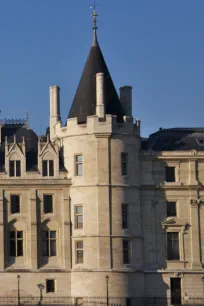Once a royal palace and later a prison, the Conciergerie played a dark role in the French Revolution and the Reign of Terror.
Palais de la Cité

Located on the west side of the Île de la Cité, the Conciergerie began its life as a royal palace – the Palais de la Cité. The impressive site was chosen by Phillippe le Bel (Philip the Fair) in the early fourteenth century so that he could build a palace that would reflect his wealth and stature. In its heyday – the Middle Ages – the palace was considered one of the finest in the world. It even included a 47-meter-tall clock tower, which boasted the first clock in Paris.



Conciergerie
By the end of that same century, however, Charles V of France and the Capetian kings chose the palaces of Louvre and Vincennes over the Palais de la Cité (which also includes the current Paris Law Courts and the magnificent Sainte-Chapelle), and what was to eventually become “The Conciergerie” was given over to the Parliament to be used for the kingdom’s administrative offices. The care of the palace was left to a gentleman known as the Concierge – thus the name – who had legal and police authority in the city.
Prison
By 1391, the palace had been converted to a prison for both common and political criminals. Wealthy prisoners were given the best accommodations in the former palace, while petty thieves were made to sleep in dark, rodent-infested rooms where they often succumbed to diseases such as the plague.
A few remnants of the Conciergerie remain from the Middle Ages: the Silver Tower, which supposedly housed the royal treasury; the Caesar Tower, named for the Roman emperors; and the Bonbec Tower, which housed a torture chamber.
During the Reign of Terror
The French Revolution (1789-1799) was one of the most violent periods in French history. During these years, the Conciergerie became famous as the location where prisoners were held before they were taken to the guillotine to be beheaded. It also housed the Revolutionary Tribunal, a court set up to trial opponents of the French Revolution.
According to records, the Tribunal sat in the Great Hall of the palace between April 1793 and May 1795 and sent nearly 2,600 prisoners to the guillotine, including Marie Antoinette. Ironically, the original head of the Tribunal, Maximilien Robespierre, was imprisoned here in the Conciergerie before being sent to the guillotine in 1794.
The Later Years

After the Revolution ended, the Conciergerie continued to be used for what the French considered the most important prisoners, such as Napoleon III.
Though it’s difficult to tell given its medieval appearance, extensive rebuilding and renovations took place at the palace in the mid-nineteenth century, including the conversion of Marie Antoinette’s cell to a chapel. The building was decommissioned for official use in 1914 and then opened to the public as a national historic monument. It remains a popular tourist attraction, though access to most of the building is severely limited.
- Next: Parc Monceau
- More Sights & Attractions in Paris

